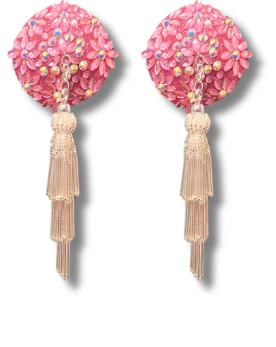Pasties nipple covers are small adhesive accessories designed to provide discreet coverage and modesty without the need for a traditional bra. They come in various shapes, sizes, and materials, including reusable silicone and single-use fabric options, offering versatility for different clothing styles and occasions. They are particularly valued for their ability to offer seamless coverage under sheer or revealing outfits, enhancing comfort and confidence.
These nipple pasties serve multiple purposes beyond modesty, such as shaping and lifting the appearance of the breasts. Many reusable options offer long-lasting wear with skin-friendly adhesives, making them a popular choice for everyday use and special events alike. Their discreet design makes them ideal for those who prefer minimal coverage or are seeking a no-bra alternative.
Whether worn for fashion, comfort, or convenience, nipple pasties have evolved into a practical wardrobe essential. Their ability to adapt to various sizes and styles ensures they cater to a wide range of needs, from casual wear to more daring looks.
Understanding Pasties Nipple
Nipple pasties serve both practical and aesthetic roles, offering coverage, protection, and style for various occasions. Their origins and materials vary, reflecting changes in fashion and functional needs over time.
Definition and Purpose
Nipple pasties, also called nipple covers, are adhesive patches designed to cover the nipples and sometimes the surrounding areola. Their primary purpose is to provide modesty under clothing where a bra may not be worn or suitable.
They help prevent nipple outlines from showing through thin or tight garments, enhancing confidence and comfort. Some pasties also serve protective functions, shielding the skin from irritation caused by friction or fabric.
Beyond concealment, many use pasties as fashion accessories, adding decorative flair during performances or special events. Their discreet design makes them popular for both everyday wear and occasions requiring unconventional wardrobe choices.
History and Cultural Significance
Nipple pasties have historical roots that trace back to burlesque and stage performances in the early 20th century. They emerged as a solution to comply with decency laws while maintaining bold, expressive costumes.
Over time, pasties evolved from simple modesty tools to symbols of empowerment and body positivity within various subcultures. They played roles in feminist movements and performances that challenged traditional norms about nudity and sexuality.
In modern fashion, pasties often appear in runway shows, music videos, and festivals, reflecting a blend of artistry and cultural statement. Their use spans entertainment, activism, and personal style, marking their place beyond mere functionality.
Common Materials and Designs
Materials for nipple pasties range from skin-friendly adhesives and silicone to fabric and decorative elements like sequins or feathers. The choice depends on comfort, durability, and the intended look.
Common types include:
- Silicone pasties: Reusable, skin-safe, and gentle on sensitive skin.
- Adhesive fabric pasties: Disposable options that come in various shapes and colors.
- Decorative pasties: Embellished with rhinestones, lace, or tassels for visual impact.
Pasties are often round but also come in shapes like hearts, stars, or abstract forms to suit personal preferences. Skin sensitivity and adhesive strength are crucial factors for ensuring comfort during wear.
How to Choose and Use Pasties Nipple
Selecting the right pasties involves paying attention to size, material, and adhesive strength. Proper application ensures comfort and secure wear, while careful removal and aftercare protect the skin and maintain pasties’ usability.
Sizing and Fit Considerations
Choosing pasties that match the size and shape of the nipple area is essential. Ill-fitting pasties can cause discomfort, slipping, or inadequate coverage. Users should measure their nipple size or choose pasties based on breast size to find the best fit.
Materials vary, but breathable and skin-friendly options, like silicone or fabric with gentle adhesive, reduce irritation risk. Disposable pasties tend to have stronger adhesives but may sacrifice comfort. Reusable silicone pasties often provide flexibility and better fit over repeated use.
She should consider the outfit type—larger, thicker pasties work better for heavier fabrics or more coverage, while thin, discreet options suit tight or sheer clothing.
Application Tips for Comfort
Skin should be clean, dry, and free from oils or lotions before applying pasties. This improves adhesion and prevents slipping during wear.
Peeling the backing carefully preserves the adhesive layer. Positioning is key; placing pasties directly over the nipple and pressing firmly ensures secure attachment.
For sensitive skin, testing a small patch first can prevent allergic reactions. If pasties start to peel during wear, gently pressing edges back down can help maintain coverage.
When using reusable pasties, following the manufacturer’s instructions on cleaning and drying before wear enhances their lifespan and comfort.
Removal and Aftercare
Removing pasties slowly and gently reduces skin irritation. Pulling from the edges and avoiding sudden force helps preserve skin integrity.
After removal, cleansing the skin with a mild, fragrance-free cleanser removes adhesive residue and soothes the area.
Applying a moisturizer or aloe vera gel can replenish moisture and calm any redness or sensitivity.
Reusable pasties should be cleaned according to their material specifications—usually with warm water and mild soap—and left to air dry to maintain stickiness and hygiene for future use.




